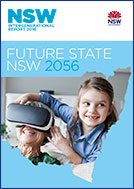The NSW Intergenerational Report (IGR) 2016-17, titled Future State NSW in 2056, provides an insight into what the State might look like in the next 40 years, outlining the challenges and opportunities for the nation’s strongest economy and fastest growing state.
The report is published every five years and projects demographic, workforce and housing trends across NSW over the coming four decades. It also provides a long-term projection of the State’s economic and fiscal position outlining the financial pressures facing NSW over the long term.
NSW Treasury is the only state Treasury which produces an Intergenerational Report. The detailed modelling and analysis undertaken by NSW Treasury enables the government of the day to take the necessary action to provide the highest possible standard of living for all our citizens into the future.
What the NSW IGR 2016-17 tells us
A good starting point
The 2016-17 Intergenerational Report shows that we are strongly placed to face the future. As it currently stands, and not to forget those in our community who are less fortunate, we are collectively wealthier, living longer and better educated than ever before.
The IGR notes that this trajectory is likely to continue to 2056.
This is a good starting point to deal with the inevitable challenges to our continued prosperity; some of which are visible today and others, like the recent Global Financial Crisis that will come as a shock.
Our ageing population
NSW has an ageing population. The median age is up from 29 in 1976 to 37 in 2015 and will rise to 41 in 2056. As the population ages, workforce participation declines and the rate of economic growth naturally slows.
An ageing population also causes the demand for services and infrastructure to grow and is expected to drive growth on government expenditures - particularly for health services. Revenue growth, however, is unlikely to keep pace with expense growth for two reasons - the expected decline in workforce participation that ageing will bring and the second is a longer-term trend of slower growth in grants from the Commonwealth Government.
A fiscal gap will emerge – if no action is taken
If we allow current trends to continue, a widening fiscal gap will emerge between what the state government receives, and what it spends on the services and infrastructure people expect. The fiscal gap is estimated to rise to 3.4 per cent of GSP by 2056, which is equivalent to $17 billion if measured against today’s GSP.
If this eventuates, net debt would rise from around one per cent of GSP today to almost 75 per cent in 2056. In that instance, a fifth of revenues would have to go from services to meet interest payments alone.
The IGR examines the choices available to Government to ensure our future is one where the living standard of our citizens continues to be world-class.
The Report contains our best projections of our fiscal future. It is important to remember that these are not predictions, but simply reasonable estimates of what might happen if Government does not intervene.


